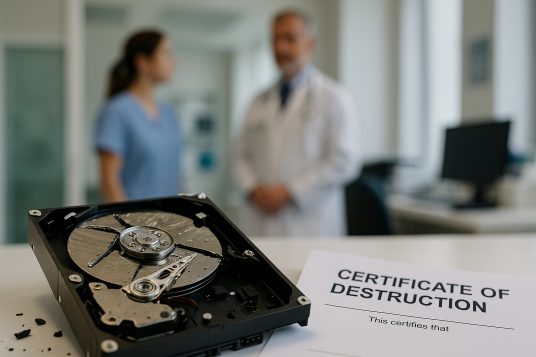
The question: Is wiping a drive enough to protect patient information? is one every healthcare organization must ask. This topic, known as media sanitization, is critical for protecting sensitive patient data. It affects every healthcare provider, clinic, and supporting business. If you handle Electronic Protected Health Information (ePHI), this applies to you.
Understanding Media Sanitization and HIPAA
Media sanitization means erasing data from storage devices so it cannot be recovered. Devices include hard drives, copiers, servers, and even old phones. For Covered Entities and Business Associates, this process is not optional. The HIPAA Security Rule demands that any ePHI on a device must be truly unusable or unreadable before it leaves your control. Simply deleting files is not enough. Criminals and data recovery experts can often still retrieve “deleted” information.
The Current Situation: A Common Pitfall
Consider this common scenario: You are replacing an old copier or computer. The vendor says they will “wipe” the hard drive. You might think the patient data is safe. However, “We wipe it” is not sufficient for HIPAA compliance. The standard of proof is much higher.
The Required Standard for Data Destruction
HIPAA does not mandate physically smashing every drive. It requires an auditable and effective method. The accepted clean ways to meet the HIPAA standard are:
- Purge the drive to NIST SP 800-88 (with documentation and proof).
- Physically destroy the drive (with documentation and proof).
The National Institute of Standards and Technology (NIST) Special Publication 800-88 offers guidelines for media sanitization. A Purge is a method that renders ePHI unusable by state-of-the-art recovery techniques. This may involve using specific software for sanitizing or crypto-erasing the drive.
Real-World Risks: Detailed Case Examples
This isn’t just a technical detail; it is a major risk. Cases have shown the severe consequences of improper sanitization. It is a case that could happen to any of us.
Case 1: The Auctioned Hard Drives 💸
In one major enforcement action, a financial services firm—a business associate—failed at proper data destruction.
- The Error: The company hired an unqualified moving company to dispose of thousands of hard drives. They did not verify the sanitization process.
- The Result: The equipment, which still contained unencrypted customer data (including personal account details), was sold at a public auction.
- The Consequence: A purchaser discovered the sensitive data and alerted the firm. This failure to follow the purge standard led to a multi-million dollar settlement with state attorneys general.
This shows that if a Business Associate fails, the Covered Entity may face liability.
Case 2: Discarded Equipment with ePHI 🏥
Several healthcare providers have faced massive fines due to improper disposal of IT equipment.
- The Error: A medical organization discarded old computer servers and hard drives without fully erasing the ePHI. They failed to implement the proper safeguards required by the HIPAA Security Rule.
- The Result: The media, containing thousands of patient records, was later recovered. The data was found to be readable.
- The Consequences: This negligence led to a large civil monetary penalty and required the organization to adopt a corrective action plan monitored by the U.S. Department of Health and Human Services (HHS) Office for Civil Rights (OCR).
These examples underscore that HIPAA requires proof of destruction. A lost or discarded drive with unpurged ePHI is treated as an impermissible disclosure or breach. Fines for willful neglect can reach over $2.1 million annually.
Protecting Your Organization: Protocols and Recommendations
To protect your organization, establish clear, documented protocols.
- Policy: Require NIST SP 800-88: Your policy must specify using NIST SP 800-88 Purge or physical destruction.
- Vendor Due Diligence: Get a Certificate of Destruction (or Purge) from every vendor. Make this a contractual requirement.
- Proof is Essential: The certificate must specify the method (e.g., NIST 800-88 Purge verified) and include the serial number.
- Inventory: Keep a detailed record of all devices that store ePHI.
- Staff Training: Train your staff—from IT to administrative personnel—on these procedures.
For deeper insights and help establishing robust compliance programs, resources like Taino Consultants and EPI Compliance offer expertise. They provide tools and guidance to help organizations navigate these complex rules. Access their websites for detailed guides and consultation. Taino Consultants has resources on data disposal best practices. EPI Compliance offers a clear path to managing your security program.
Actionable Next Steps
We are all responsible for protecting patient data. Do not settle for a vendor saying “wiping is good enough.” Demand a verified Purge or documented physical destruction. This simple step protects your patients and your organization.
Take control now: review, refresh, and actively manage your program. For quick, practical guidance, see EPI Compliance webcasts (Watch on YouTube).
Make it fit every healthcare organization
This process works for hospitals, FQHCs, imaging centers, dental practices, PT clinics, and billing companies. The devices may change, but the rule does not. If it held ePHI, sanitize it or destroy it. If a vendor touches it, make them sign for it. If you cannot prove it, treat it like a risk.
Personal note
I know this can feel like “one more thing.” But this is one of the few controls that can stop a front-page story. Disposal is where many good organizations get hurt. You can fix this with one clear policy, one inventory sheet, and one training session. That is why I push this topic so hard. It protects your patients, your reputation, and your license.
Call to action
Take control now: review, refresh, and actively manage your program. For quick, practical guidance, see EPICompliance webcasts (Watch on YouTube).
